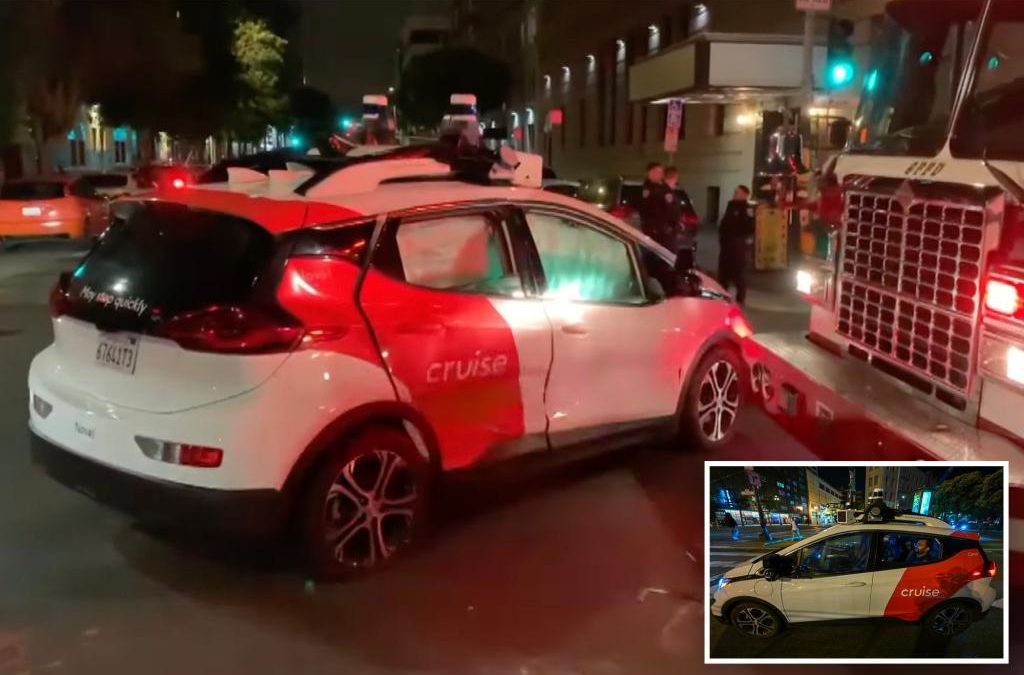General Motors’ robotaxi operator Cruise is planning to reduce the size of its fleet of self-driving cars by half in San Francisco after several collision incidents — this just days after California regulators gave the company and its competitor, Waymo, the green light to operate autonomous vehicles 24 hours a day.
The California Department of Motor Vehicles told CNBC that the startup made the move after several road incidents involving self-driving taxis.
The DMV confirmed the decision by Cruise in an emailed statement to The Post.
The apparent safety risk posed by the autonomous taxis is fueling concern among residents and civic activists who fear that state regulators jumped the gun in granting approval to the two companies to ramp up operations in the city.
The accidents also came on the heels of a report last week in which passengers of driverless taxis reported that they were involved in sexual encounters while riding the vehicles.
“Over one hundred people lose their lives every day on American roadways, and countless others are badly injured,” a Cruise spokesperson told The Post.
“We believe it’s clear that Cruise positively impacts overall road safety, and look forward to working with the CA DMV to make any improvements and provide any data they need to reinforce the safety and efficiency of our fleet.”
Cruise has agreed to deploy no more than 50 driverless taxis during the day throughout the city as well as a maximum of 150 in the evening hours, according to the DMV.
Earlier this month, Cruise said it was operating 300 cars during the night and 100 during the day.

A driverless Cruise taxi collided with a firetruck in San Francisco late on Thursday night, injuring a passenger. The passenger, who was not seriously hurt, was taken to a hospital.
The firetruck was apparently rushing to the scene of an emergency when it swerved into oncoming traffic in order to get around cars.
The truck then collided with a Cruise car that had crossed a green light into the intersection of Polk and Turk Streets in the Tenderloin District where the collision took place.

Greg Dietrerich, the general manager of Cruise’s San Francisco operations, wrote a blog post on Friday saying that “several factors” contributed to the incident, including the fact that buildings at the intersection made it difficult for the car’s systems to spot the emergency vehicle.
Dietrerich wrote that the firetruck veered into the wrong lane to “bypass” a red light.

“We will continue to work in partnership with regulators and city departments on EMV interactions to reduce the likelihood of incidents like these happening again,” Dietrerich wrote.
Just two hours after the collision in Tenderloin, a Cruise robotaxi was hit by a Dodge Charger in the Mission District section of the city.
The driver of the Dodge was treated for non-life threatening injuries. Witnesses said that the Dodge was “completely totaled,” according to a dispatch from CBS Bay Area.
San Francisco residents earlier this month posted a video to social media showing a massive traffic jam caused by some 10 Cruise robotaxis that were unable to move due to “wireless connectivity issues” caused by a mass of people who were attending a nearby music festival.
Another social media post showed a Cruise robotaxi driving into a patch of wet cement on a sidewalk.
“The DMV is investigating recent concerning incidents involving Cruise vehicles in San Francisco,” a DMV spokesperson told CNBC in a statement.

“The DMV is in contact with Cruise and law enforcement officials to determine the facts and requested Cruise to immediately reduce its active fleet of operating vehicles by 50% until the investigation is complete and Cruise takes appropriate corrective actions to improve road safety.”
The Post has sought comment from Cruise and Waymo.
Source




